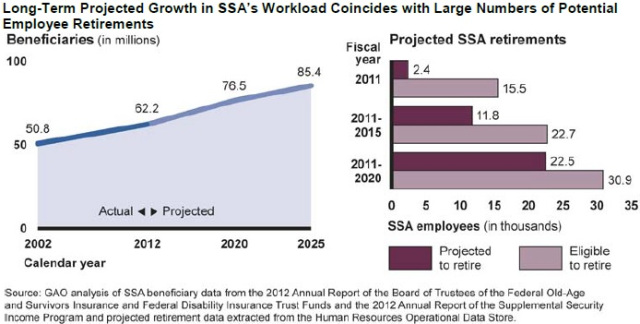How Is SSA Keeping Up at 80?
Eighty years after FDR signed it into existence, the Social Security Administration is managing one of the nation’s largest social safety nets. SSA oversees hundreds of billions in benefits paid to around 60 million retired or disabled Americans every year.
While much of the conversation about Social Security focuses on its projected financial shortfall, SSA faces additional challenges in efficiently and effectively providing benefits. Today’s WatchBlog focuses on the agency’s physical presence, workload management, and disability determinations.
The costs of customer service
SSA considers face-to-face interactions to be the gold standard of customer service. Every day, its field offices see some 182,000 visitors while taking another 445,000 calls.
To help answer beneficiaries’ questions and process applications, over 80,000 people in 1,700 facilities nationwide perform work for SSA. This space costs around $700 million a year, according to the agency.
As SSA provides more services online, its space needs could change. Could the agency save money by shrinking its offices? SSA is beginning to centralize its facilities management, but needs to have the proper analyses to help ensure that changes effectively and efficiently support its mission.
We recommended that SSA perform these types of analyses and develop a long-term strategy for service delivery. Without such a strategy, the agency will be poorly positioned to make decisions about its critical functions.
A potential boomer bust
SSA’s workloads are surging as baby boomers enter retirement age and their disability-prone years. At the same time, we found that many of SSA's most experienced staff are poised to retire.
 (Excerpted from GAO-13-459)
(Excerpted from GAO-13-459)
We recommended SSA update its succession plan to mitigate the potential loss of institutional knowledge and expertise, and the agency has since taken steps to do so.
A better approach to disability determinations
As SSA ages, it needs to keep up with new developments. Specifically, how it determines someone’s eligibility for disability benefits should reflect new research and medical advances. For example, a modern concept of disability should recognize that being able to work isn’t just about a medical condition, but the interaction of that condition with:
- available assistive devices, like a prosthetic leg or reading device; and
- environment, such as accessible transportation and workplace accommodations.
Under this definition, two people with the same medical condition might have different degrees of work disability. Outdated concepts of disability helped land SSA on our High Risk List in 2003.
SSA has efforts underway to modernize its disability assessments. For example, it intends to study options for more fully considering assistive devices or workplace accommodations in making disability determinations.
Looking ahead
In our recent 2015 High Risk List update, we outlined what SSA still needs to do to stay on top of these challenges. We will continue to monitor SSA’s efforts to implement our recommendations, and update our list accordingly.
- Questions on the content of this post? Contact Dan Bertoni at BertoniD@gao.gov.
- Comments on GAO’s WatchBlog? Contact blog@gao.gov.





